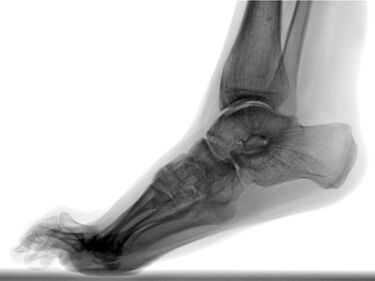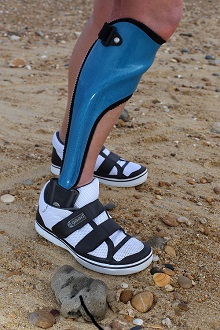Equinus Deformity: Difference between revisions
Aya Alhindi (talk | contribs) No edit summary |
Aya Alhindi (talk | contribs) No edit summary |
||
| Line 7: | Line 7: | ||
[[File:Equinus deformity X-ray.jpg|thumb|375x375px|equinus foot X-ray]] | [[File:Equinus deformity X-ray.jpg|thumb|375x375px|equinus foot X-ray]] | ||
Pes Equinus is a condition in which the upward bending motion of the ankle joint (dorsiflexion) is limited.<ref name=":0">Equinus. Equinus - Foot Health Facts. (n.d.). Retrieved November 27, 2022, from https://www.foothealthfacts.org/conditions/equinus .</ref> It's also known as tight calf and is typically associated condition of a primary diagnosis of a bunion( [https://www.physio-pedia.com/Hallux_Valgus?utm_source=physiopedia&utm_medium=search&utm_campaign=ongoing_internal Hallux valgus]) and most commonly seen in flat foot or [https://www.physio-pedia.com/Pes_cavus?utm_source=physiopedia&utm_medium=search&utm_campaign=ongoing_internal pes cavus].<ref>Equinus. Pes equinus - an overview | ScienceDirect Topics. (n.d.). Retrieved November 27, 2022, from https://www.sciencedirect.com/topics/medicine-and-dentistry/pes-equinus .</ref>In this deformity, an alteration in gait may occur; a patient may also have difficulty climbing stairs, dressing and in lifting the foot up so a patient may need to lift the leg on the affected side up higher, to “step over” the foot.<ref>Equinus foot and ankle deformity: Baltimore, MD. International Center for Limb Lengthening. (2022, September 22). Retrieved November 27, 2022, from https://www.limblength.org/conditions/equinus-foot-deformity/</ref> | Pes Equinus is a condition in which the upward bending motion of the ankle joint (dorsiflexion) is limited.<ref name=":0">Equinus. Equinus - Foot Health Facts. (n.d.). Retrieved November 27, 2022, from https://www.foothealthfacts.org/conditions/equinus .</ref> It's also known as tight calf and is typically associated condition of a primary diagnosis of a bunion( [https://www.physio-pedia.com/Hallux_Valgus?utm_source=physiopedia&utm_medium=search&utm_campaign=ongoing_internal Hallux valgus]) and most commonly seen in flat foot or [https://www.physio-pedia.com/Pes_cavus?utm_source=physiopedia&utm_medium=search&utm_campaign=ongoing_internal pes cavus].<ref>Equinus. Pes equinus - an overview | ScienceDirect Topics. (n.d.). Retrieved November 27, 2022, from https://www.sciencedirect.com/topics/medicine-and-dentistry/pes-equinus .</ref>In this deformity, an alteration in gait may occur; a patient may also have difficulty climbing stairs, dressing and in lifting the foot up so a patient may need to lift the leg on the affected side up higher, to “step over” the foot.<ref>Equinus foot and ankle deformity: Baltimore, MD. International Center for Limb Lengthening. (2022, September 22). Retrieved November 27, 2022, from https://www.limblength.org/conditions/equinus-foot-deformity/</ref> | ||
== Classification == | == Classification == | ||
Equinus can be classified in multiple ways according to etiology, apex of equinus, spastic and non-spastic forms in addition to soft tissue causes of joint restriction.<ref>Tiberio D. Pathomechanics of structural foot deformities. Phys Ther. 1988 Dec;68(12):1840-9. doi: 10.1093/ptj/68.12.1840. PMID: 3194451.</ref> | Equinus can be classified in multiple ways according to etiology, apex of equinus, spastic and non-spastic forms in addition to soft tissue causes of joint restriction.<ref>Tiberio D. Pathomechanics of structural foot deformities. Phys Ther. 1988 Dec;68(12):1840-9. doi: 10.1093/ptj/68.12.1840. PMID: 3194451.</ref> | ||
| Line 61: | Line 63: | ||
* '''Heel lifts''' | * '''Heel lifts''' | ||
* '''Arch supports or orthotic devices:''' | * '''Arch supports or orthotic devices:''' | ||
[[File:Ankle Foot Orthosis AFO.jpeg|thumb|ankle foot orthosis]] | |||
Ankle-foot orthoses (AFO) are regarded as an efficient conservative treatment for slowing the progression of equinus deformities because they serve to restrict ankle plantar flexion and offer passive stretching for the tight soft tissues.<ref> Chen, Wei PhDa; Liu, Xiaoyu PhDa; Pu, Fang PhDa,b,*; Yang, Yang PhDa; Wang, Lizhen PhDa; Liu, Hong MDd; Fan, Yubo PhDa,b,c,*. Conservative treatment for equinus deformity in children with cerebral palsy using an adjustable splint-assisted ankle-foot orthosis. Medicine: October 2017 - Volume 96 - Issue 40 - p e8186 | Ankle-foot orthoses (AFO) are regarded as an efficient conservative treatment for slowing the progression of equinus deformities because they serve to restrict ankle plantar flexion and offer passive stretching for the tight soft tissues.<ref> Chen, Wei PhDa; Liu, Xiaoyu PhDa; Pu, Fang PhDa,b,*; Yang, Yang PhDa; Wang, Lizhen PhDa; Liu, Hong MDd; Fan, Yubo PhDa,b,c,*. Conservative treatment for equinus deformity in children with cerebral palsy using an adjustable splint-assisted ankle-foot orthosis. Medicine: October 2017 - Volume 96 - Issue 40 - p e8186 | ||
doi: 10.1097/MD.0000000000008186 </ref> | doi: 10.1097/MD.0000000000008186 </ref> | ||
| Line 69: | Line 71: | ||
Therapeutic interventions such as stretching and active movement of calf muscles are recommended To help remedy muscle tightness.<ref> Zahran, D.A.E., Bahr, W.M. & Abd Elazim, F.H. Systematic review: exercise training for equinus deformity in children with cerebral palsy. Bull Fac Phys Ther 27, 37 (2022). https://doi.org/10.1186/s43161-022-00093-9 </ref> | Therapeutic interventions such as stretching and active movement of calf muscles are recommended To help remedy muscle tightness.<ref> Zahran, D.A.E., Bahr, W.M. & Abd Elazim, F.H. Systematic review: exercise training for equinus deformity in children with cerebral palsy. Bull Fac Phys Ther 27, 37 (2022). https://doi.org/10.1186/s43161-022-00093-9 </ref> | ||
{{#ev:youtube|K3TUi0OKV6w}} | {{#ev:youtube|K3TUi0OKV6w}} | ||
==Surgery== | ==Surgery== | ||
If a bone or tight tendon is restricting the motion of the ankle, surgery may occasionally be required to treat the underlying condition that is causing equinus. There are some risks that are associated with all surgeries, and they differ from patient to patient. Most complications are small, manageable, and unlikely to have an impact on patients. <ref name=":1" /> | If a bone or tight tendon is restricting the motion of the ankle, surgery may occasionally be required to treat the underlying condition that is causing equinus. There are some risks that are associated with all surgeries, and they differ from patient to patient. Most complications are small, manageable, and unlikely to have an impact on patients. <ref name=":1" /> | ||
Revision as of 00:54, 8 December 2022
Original Editor - Aya Alhindi
Top Contributors - Aya Alhindi, Aminat Abolade and Kirenga Bamurange Liliane
Introduction[edit | edit source]
Pes Equinus is a condition in which the upward bending motion of the ankle joint (dorsiflexion) is limited.[1] It's also known as tight calf and is typically associated condition of a primary diagnosis of a bunion( Hallux valgus) and most commonly seen in flat foot or pes cavus.[2]In this deformity, an alteration in gait may occur; a patient may also have difficulty climbing stairs, dressing and in lifting the foot up so a patient may need to lift the leg on the affected side up higher, to “step over” the foot.[3]
Classification[edit | edit source]
Equinus can be classified in multiple ways according to etiology, apex of equinus, spastic and non-spastic forms in addition to soft tissue causes of joint restriction.[4]
Etiology/Causes[edit | edit source]
Equinus is frequently caused by tightness in the calf muscles (the soleus and/or gastrocnemius muscles) or the Achilles tendon. Some people may have this feature congenitally (existing at birth) or inherited it. Others develop this tightness as a result of wearing high-heeled shoes frequently, being in a cast or using crutches. Other contributing factors include diabetes or having a shorter leg than other. The patient may develop equinus if a bone or bone fragment restricts movement of the ankle (for instance, after an ankle injury). Rarely, calf muscular spasms can induce equinus and may be a symptom of an underlying neurologic condition.Equinus.[5]
Foot Problems Related to Equinus[edit | edit source]
A number of foot problems can arise depending on how a patient compensates for their inability to bend appropriately at the ankle, including:[6]
- Plantar fasciitis (arch/heel pain)
- Calf cramping
- Tendonitis (inflammation in the Achilles tendon)
- Metatarsalgia (pain and/or callusing on the ball of the foot)
- Flatfoot
- Arthritis of the midfoot (middle area of the foot)
- Pressure sores on the ball of the foot or the arch
- Bunions and hammertoes
- Ankle pain
- Shin splints
Diagnosis[edit | edit source]
When people initially contact the doctor, the majority of those with equinus are not aware they have this condition. Instead, they come seeking relief for equinus-related foot issues.[6]
Key diagnostic factors:[edit | edit source]
- positive family history.
- equinus deformity.
- hind foot in varus and adduction.
- adduction of forefoot.
Other diagnostic factors:[edit | edit source]
- male sex.
- hip dysplasia.
- neurologic or chromosomal abnormalities.
- smaller lower extremity.
Investigations:[edit | edit source]
- anteroposterior and lateral radiographs of foot.
- dynamic hip ultrasound.
- pelvic radiographs.
- CT foot.
Special test:[edit | edit source]
The Silfverskiöld test can be used to differentiate gastrocnemius tightness from an achilles tendon contracture by evaluating ankle dorsiflexion with the knee extended and then flexed.[8]
Technique:[edit | edit source]
The test is performed with the patient seated or in supine. Two hands are utilized to perform the technique, with one hand neutralizing and locking the subtalar (ST) joint and the other stabilizing the talonavicular (TN) joint and forefoot in order to isolate the ankle joint motion. Then the forefoot is supinated and foot is dorsiflexed with knee in full extension.Measurement is taken of the DF range. Then the test is repeated with knee flexed at 90 degrees.[9]
- Less dorsiflexion with a soft and spongy feel when the knee is extended is considered as an indication for gastrocnemius contracture.
- Equally limited dorsiflexion with the knee flexed and extended is considered as an indication for soleal equinus or an osseous block.
Non-surgical Treatment[edit | edit source]
Non surgical treatment strategies are aimed at relieving the symptoms and conditions associated with equinus rather than correcting the deformity itself. Some examples include:[6]
- Night splint
- Heel lifts
- Arch supports or orthotic devices:
Ankle-foot orthoses (AFO) are regarded as an efficient conservative treatment for slowing the progression of equinus deformities because they serve to restrict ankle plantar flexion and offer passive stretching for the tight soft tissues.[10]
- Physical therapy:
Therapeutic interventions such as stretching and active movement of calf muscles are recommended To help remedy muscle tightness.[11]
Surgery[edit | edit source]
If a bone or tight tendon is restricting the motion of the ankle, surgery may occasionally be required to treat the underlying condition that is causing equinus. There are some risks that are associated with all surgeries, and they differ from patient to patient. Most complications are small, manageable, and unlikely to have an impact on patients. [6]
- ↑ Equinus. Equinus - Foot Health Facts. (n.d.). Retrieved November 27, 2022, from https://www.foothealthfacts.org/conditions/equinus .
- ↑ Equinus. Pes equinus - an overview | ScienceDirect Topics. (n.d.). Retrieved November 27, 2022, from https://www.sciencedirect.com/topics/medicine-and-dentistry/pes-equinus .
- ↑ Equinus foot and ankle deformity: Baltimore, MD. International Center for Limb Lengthening. (2022, September 22). Retrieved November 27, 2022, from https://www.limblength.org/conditions/equinus-foot-deformity/
- ↑ Tiberio D. Pathomechanics of structural foot deformities. Phys Ther. 1988 Dec;68(12):1840-9. doi: 10.1093/ptj/68.12.1840. PMID: 3194451.
- ↑ Equinus - Foot Health Facts. (n.d.). Retrieved November 27, 2022, from https://www.foothealthfacts.org/conditions/equinus .
- ↑ 6.0 6.1 6.2 6.3 Foot & Ankle. Equinus | Foot & Ankle. (n.d.). Retrieved November 27, 2022, from https://www.shorelineortho.com/specialties/foot_ankle_equinus.php#:~:text=Equinus%20is%20often%20it%20is,frequently%20wearing%20high%2Dheeled%20shoes.
- ↑ Equinovarus Foot Deformity. Equinovarus foot deformity - Symptoms, diagnosis and treatment | BMJ Best Practice US. (n.d.). Retrieved November 27, 2022, from https://bestpractice.bmj.com/topics/en-us/745
- ↑ DiGiovanni CW, Kuo R, Tejwani N, et al: Isolated gastrocnemius tightness. J Bone Joint Surg Am 2002;84(6):962-970.
- ↑ Hansen ST. Functional reconstruction of the foot and ankle. Lippincott Williams & Wilkins; 2000.
- ↑ Chen, Wei PhDa; Liu, Xiaoyu PhDa; Pu, Fang PhDa,b,*; Yang, Yang PhDa; Wang, Lizhen PhDa; Liu, Hong MDd; Fan, Yubo PhDa,b,c,*. Conservative treatment for equinus deformity in children with cerebral palsy using an adjustable splint-assisted ankle-foot orthosis. Medicine: October 2017 - Volume 96 - Issue 40 - p e8186 doi: 10.1097/MD.0000000000008186
- ↑ Zahran, D.A.E., Bahr, W.M. & Abd Elazim, F.H. Systematic review: exercise training for equinus deformity in children with cerebral palsy. Bull Fac Phys Ther 27, 37 (2022). https://doi.org/10.1186/s43161-022-00093-9








